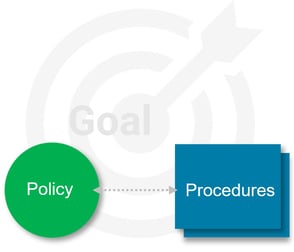
Refining business operations, changing regulatory requirements, or threats to information security are just a few reasons you may be looking for tips to improve policy management. This initiative can include the entire organization or start with a single department. Ideally, you have evolved beyond binders and paper documents and are following best practices using policy management software. Either way, you understand the importance of policy management. It’s a continuous process to keep employees updated with the latest information on regulation and policy changes.
Let’s get to the tips.
Tips to Improve Policy Management
1. Develop a clear policy framework
Establish a clear policy framework that outlines the objectives, scope, and implementation of policies in your organization. This also includes separating policies and procedures, so you need a clear definition of each.
A policy is a guideline or statement of position with respect to a given topic.
A procedure is the “how-to.” It’s the step-by-step instructions for completing a task and how to comply with a policy. Build a framework that is easy to update for any process, department, or policy. We use a method called Operations Mapping which allows our clients to systematically break down high-level processes into operation procedures, detailed tasks, and guiding policies. Separate policies and procedures into separate documents, but LINK them together. This makes it easier for employees to find what they need and also makes change management much easier.
2. Link to economic business outcomes
An effective policy management program links to measurable business outcomes. What is your why? What is the performance or operational outcome you are looking to achieve? And is there a problem you are trying to solve?
-
Are you preparing for an audit?
-
Are you trying to save time when onboarding new employees?
-
Are you going through multiple mergers and acquisitions and need to standardize policies and provide clear guidelines on system migrations?
-
Are you recovering from a data breach and need more rigorous data protection among all employees?
-
Has something changed with regulatory compliance, and you need to align your business process?
3. Identify subject matter experts
Your subject matter experts for writing policies are seasoned professionals. They’ve likely been in their role for a long time, are the policy managers, and have valuable tribal knowledge that is important to document. Examples include:
-
Human Resources is responsible for the code of conduct, vacation, and disciplinary policies.
-
IT will handle cybersecurity, internet use, and data backup policies.
-
Legal will require policies regarding ethics, discrimination, or nepotism.
-
Operations may focus on crisis and risk management.
-
Marketing may wish to implement a social media policy and require a privacy policy for the company website.
4. Secure senior management support
We have found our most successful clients have the support of their executive leadership team. The company has made this a priority. Managers allow time for team members to dedicate to writing new policies or updating existing policies. Some clients involve the Chief Compliance Officer. This role oversees corporate policies and ensures the information gets in front of the right people. Larger clients have a quality control manager who coordinates policy management across different departments and business units. Another client has a company-wide digital transformation campaign. Our policy management solution aligns to this larger initiative so there is no resistance.
5. Communicate policies effectively
Communicate policies clearly and effectively to all stakeholders, including employees, managers, and external partners or customers. Use a variety of communication channels, such as email, newsletters, and training sessions, to ensure that policies are understood and implemented consistently. Having a centralized repository with easy access and search capabilities is also important. An intuitive platform will make it easy for employees to locate the right policies in the moment of need. When you’re writing a policy, be specific; avoid vague language. You want to make sure it is crystal clear what employees should do. You don’t want anyone to ever say, “You didn’t tell me I couldn't do it!”
6. Establish a policy review process
Establish a process for reviewing and updating policies on a regular basis to ensure they remain timely, relevant, and effective. This can involve regular audits, feedback from stakeholders, and monitoring of policy implementation. Streamline the policy lifecycle with a structure for authoring, version control, tracking, reviews, and approval. Monitor usage analytics and leverage this data for recommended changes and updates.
7. Ensure policies are compliant
Ensure that policies are compliant with relevant laws and regulations. This can involve working closely with legal and regulatory teams to ensure that policies are up-to-date and in line with current requirements. One client cross references 400 regulations with 300 policies and procedures. Each regulation is cross-referenced with the SOP that satisfies that regulation. This approach shows compliance, that everything is accounted for, and provides transparency for inspectors. Their last inspection only took 3.5 hours with no deficiencies. Normally, this type of inspection takes 8 hours. They were proud to “show off” their system!
8. Create corresponding procedures
Creating policies by themselves is a good start, but it’s equivalent to saying something like: “It is our policy to be an equal opportunity employer,” or “It is our policy to [fill in the blanks], and that’s it.” It’s then up to the employee to figure out how to make it happen on their own. This is risky at best and can often be disastrous. Employees need to understand the related procedures.
9. Provide policy training
Go beyond employee onboarding and provide regular training to employees on policies and their implementation. This can help you ensure that policies are implemented consistently and that employees understand their roles and responsibilities. You can use features like attestation and testing to ensure employees are reading policies and understand them.
Modernize your policy management system with Zavanta
We are reinventing how operational knowledge is captured, communicated, and utilized. Zavanta is a complete solution intentionally designed to drive desired outcomes by ensuring everyone has access to accurate and “how to” knowledge. This includes policies, procedures, best practices, checklists, manuals, and FAQs.
Zavanta is a cloud-based platform with everything you need to get the job done as pain-free as possible. Most importantly it gives your employees a single source of truth, an excellent user experience, and the direction they need to achieve performance and business goals. Contact us to start a conversation about how we can help.
Additional Resources
.png?width=289&height=63&name=full%20logo%20(white).png)

